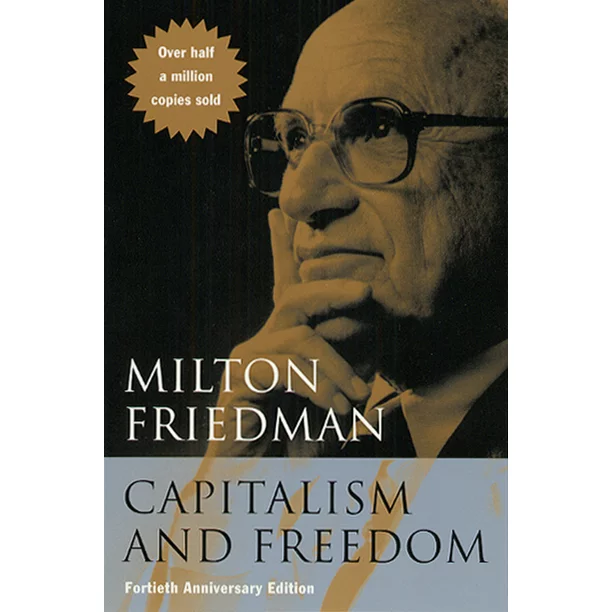Defining Tyranny Down
Parroting Michael Harrington’s leftist tract The Other America, and ignoring the extensive apparatus of existing economic regulation, a bleeding-heart “reform conservative” advances democratic socialist rhetoric and policies. No thank you.
This essay originally appeared in Law & Liberty on August 15, 2023 (here). Thanks to Power Line, Real Clear Policy (here), and Cafe Hayek!
What does conservatism mean in the 21st century? Many center-right policy wonks seem confused. In a prior era, the sturdy “three-legged stool” model of conservatism, which Frank Meyer dubbed “fusionism,” successfully combined advocacy of free-market economics, traditional morality, and anti-Communism. During the latter-half of the 20th century, this model reigned supreme. The various factions of the Right peacefully coexisted, for the most part. Jerry Falwell’s Moral Majority marched arm-in-arm with establishment think tanks (such as the Heritage Foundation), and free-market advocates. The flotilla of center-right publications of the day (e.g., National Review, The American Spectator, Policy Review) featured content from throughout the tri-legged spectrum.
Then, toward the end of the 20th century, things changed. The Soviet Union collapsed, the global economy emerged, and in place of the Cold War came futile interventionism and “nation building” in the Middle East. Big Business, once a champion of the national interest, put its muscle behind free trade and open borders. Republican elected officials followed suit, even if the GOP platform paid lip service to the importance of controlling illegal immigration. During the GWB and Obama administrations, in the absence of a strong national conservative leader in the model of Ronald Reagan, the catechism of conservatism became shaped by Beltway-based think tanks and publications.
As a result, the three-legged stool was replaced by a neo-con foreign policy and a dogmatic laissez-faire approach to the economy, even as the American middle class was gutted by off-shoring manufacturing and a glut of illegal aliens performing unskilled labor at low wages. Simultaneously, Silicon Valley oligarchs created powerful monopolies that made the handiwork of Gilded Age industrialists seem trivial in comparison. Conservatism had an identity crisis, resulting in the election of a populist candidate, Donald Trump, to the White House in 2016. In hindsight, this was not a fluke. The earlier candidacies of Pat Buchanan, Ross Perot, and even George Wallace, were a harbinger of populism to come.
Post-Trump, conservatism is still trying to regain its bearings—unable to agree what is worth conserving. The center-right coalition is busy re-inventing itself—or trying to. The Republican Party now appeals primarily to non-college educated middle class Americans in the heartland, while coastal elites, urban enclaves, and suburban women “belong” to the Democrats. What does this mean in terms of policy prescriptions? The once-united scribblers on the Right are now fragmented, and sometimes antagonistic to one another. Some of the suggested policy prescriptions deviate markedly from the Reagan era paradigm, but that’s the point. New is better. Or is it?

Some of the “fresh thinking” is strangely reminiscent of New Deal-style policies and Marxist critiques of capitalism. Sohrab Ahmari’s new book, Tyranny, Inc. is a prime example. Instead of Milton Friedman’s axiom that economic freedom—in the form of capitalism–is an essential element of political freedom, Ahmari advances the opposite theory: the subtitle of his book is How Private Power Crushed American Liberty and What to Do About It. Ahmari dismisses Nobel laureate Friedman’s teachings as “a fantasy.”
Ahmari’s book is not just a broadside against Big Tech and globalism; it is a jeremiad against free markets in general. If one did not know the author’s identity, it would be easy for a reader to conclude that Tyranny, Inc. was written by a democratic socialist in the vein of Michael Harrington. This is a blunt assessment, but hear me out. There is a big difference between “reforming” conservative policies and adopting in their place radical leftist talking points.
I approach this topic as someone who identifies as both a conservative and a populist, who enthusiastically voted for Donald Trump twice. I am emphatically not a libertarian. The domestic economy and American families can be strengthened, and we can secure our borders, without abandoning support for economic freedom and private property. Ditto antitrust enforcement to break up monopolies, and enacting policies to enhance middle class wage growth. But anti-capitalistic rhetoric—or, worse, outright corporatism–is not the solution. Ahmari’s Acknowledgements include a nod to a fellow integralist, “[m]y friend Adrian Vermeule of Harvard Law School,” a scholar who is not, at least to my mind, conservative or a friend of conservatives. The book goes downhill from there.
Government action is not needed to create tyranny, Ahmari posits; a greater problem is “private coercion in the workplace and the marketplace.” Classical liberals celebrate voluntary economic exchanges as the antithesis of coercion, but Ahmari views consumer consent as a “fig leaf” and derides economic autonomy (freedom of contract and property rights) as a myth, citing an obscure progressive law professor of the 1920s-1940s named Robert Hale (brought to Ahmari’s attention by the aforementioned Adrian Vermeule). Indeed, Hale’s notion that property ownership is inherently coercive comes close to the anarchist slogan “Property is theft.” Ahmari is just warming up.

In later chapters he inveighs against private employers’ ability to promulgate workplace policies and condition employment on execution of routine written agreements dealing with proprietary information, confidentiality, and other ubiquitous matters. Ahmari calls such agreements (which no one is forced to sign) “unfair,” “coercive,” and “exploitative.” Ahmari is particularly exercised about workplace and consumer arbitration agreements, which have been commonplace for decades—and upheld (or, as Ahmari prefers, “fetishized”) by the U.S. Supreme Court in “cruel” decisions written by Justices Scalia and Gorsuch (not normally regarded as shills for tyranny), over the dissent of Justice Ruth Bader Ginsburg, who Ahmari approvingly quotes at length.
Ironically, union contracts, which Ahmari believes would level the economic playing field, invariably contain arbitration clauses.
Echoing Marx, Ahmari suggests that the employment relationship itself is inherently coercive. He laments the Supreme Court’s “infamous Lochner era (1897-1937)” because the high court “struck down numerous reforms aimed at…redressing the power imbalance between labor and capital.” Apparently, Vermeule did not direct Ahmari to the more-nuanced work of David Bernstein, which goes uncited.
In Ahmari’s own words: “The liberty-of-contract framework is farcical”; “economic libertarians…dominate our judiciary”; the “supposed symmetry” of at-will employment (leaving employer and employee mutually free to end the relationship at any time) is “downright depraved”; “the predations of hedge funds and private equity” —not shifts in retailing—were responsible for the bankruptcy of Sears Roebuck; “the U.S. economy is anything but ‘free’”; the decline of newspapers in the U.S. is likewise due to “Wall Street looters” and hedge fund “vultures,” not changing tastes, the internet, and the disappearance of classified ads; pharmaceutical companies taking refuge in Chapter 11 to avoid a scourge of junk science lawsuits (such as blaming Johnson & Johnson baby powder for mesothelioma) are “insidious” and exploit “the power inequalities to which market societies are especially prone”; and “[t]he neoliberal state [which Ahmari contends includes the U.S. since the 1980s]…actively abets private tyranny.” (Emphasis in original.)
Ahmari warns that offering simple solutions to the problems he anecdotally recounts “would defer a reckoning with the more fundamental forces behind private tyranny,” namely the “class-based inequalities in power and income that are inherent to the workings of unrestrained capitalism.” Unrestrained capitalism? Is Ahmari unfamiliar with the Progressive Movement, New Deal, Great Society, and companion state programs, which created a vast social safety net in America while simultaneously regulating the economy in microscopic detail? Ahmari condemns “market utopianism” without pausing to consider the converse: “redistributionist utopianism,” also known as the folly of central planning.
To eliminate “class-based inequalities,” Ahmari advocates a radical restructuring of our institutions. Ahmari favors a host of federal mandates, such as limiting campaign spending by corporations (which are “fictitious legal persons”), banning non-compete clauses (a la Biden’s FTC), and adopting Sen. Elizabeth Warren’s proposed Wall Street reforms. Ahmari’s most misguided policy prescription, however, which forms the centerpiece of his book, is the dramatic revitalization of the American labor movement—what he dubs “renewing political-exchange capitalism.”
To curb “private tyranny,” Ahmari avers, we need more powerful labor unions, covering a greater percentage of the American workforce: “The goal should be a labor market in which most sectors are unionized.” (Never mind that compulsory union dues, exclusive representation, union discipline, union corruption, and violent labor disputes merely represent a different form of coercion and abuse.) Ahmari is nostalgic for the heyday of unionism in the U.S., which peaked at around 35 percent of the workforce in 1954. The unionized share of the private-sector workforce in 2022 was six percent, and continues to decline. (The percentage of unionized government employees is much higher.) Ahmari hopes to return to “the type of labor militancy that characterized the late nineteenth and early twentieth centuries.” Seriously? A reprise of the Homestead strike, Pullman strike, Haymarket bombing, etc.?
Ahmari posits that widespread unions would correct the imagined asymmetry between capital and labor, solving the power imbalance “inherent to the class structure.” Through collective-bargaining, unions could demand higher wages, ensure fairness in the workplace, and resurrect “the older model of retirement based on defined benefits.” If collective-bargaining is, as Ahmari claims, the New Deal’s “signal achievement” and its “most transformative element,” and if stronger unions could—by creating “countervailing power”—correct market abuses, why have American workers largely chosen to avoid union representation?
The mechanics of union elections, which rest on employee choice, have been essentially unchanged since enactment of the National Labor Relations Act in 1935. Ahmari risibly suggests that the nation’s labor laws favor employers, ignoring the longstanding pro-union bias of the National Labor Relations Board.
The precipitous decline of the heavily-unionized American automobile industry, which once enjoyed almost total domination of the U.S. auto market, demonstrates that strong unions are not a panacea. Nor can collective-bargaining, without concomitant productivity gains, increase wage rates in a competitive economic market. More importantly, an overwhelming majority of American workers have shown that they simply do not wish to be represented by unions.
Many reform-cons, integralists, and academics who have never turned a wrench or performed manual labor incongruously imagine themselves as arm-chair union organizers, forgetting that our modern-day “proletariat” lacks the class-consciousness apparently prevalent in faculty lounges or the editorial office of Compact and similar journals. Alas, 2023 is not 1935, and to the chagrin of New Deal enthusiasts, American workers in the private sector tend to embrace the cultural values of the bourgeoisie. Accordingly, Ahmari’s “solution” is a chimera, no more convincing than his flimsy attack on free markets.
Pundits have coined a term for conservatives preoccupied with class conflict: right-wing Marxism. I hesitate to apply that epithet here only because I did not detect even a scintilla of true conservatism in Tyranny, Inc., which struck me as a shrill, superficial rehash of Marxist concepts. Despite Ahmari’s extensive reliance on leftist sources and arguments, Tyranny, Inc. has been panned by the Left, and, for the reasons outlined above, it is doubtful that it will earn many converts on the Right.

































